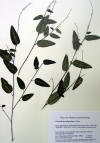|
Desmodium psilophyllum |
|
|
Botta B., E. Gacs-Baitz, V. Vinciguerra and G. Delle Monache. 2003. Three isoflavanones with cannabinoid-like moieties from Desmodium canum. Phytochemistry 64(2): 599–602. “Three further derivatives of 5,7,2',4'-tetrahydroxy-6-methyl isoflavanone have been isolated from the root extract of Desmodium canum and assigned the structures 2,3-dihydro-5,7-dihydroxy-6-methyl-3-(1a,2,3,3a,8b,8c-hexahydro-6-hydroxy-1,1,3a-trimethyl-1H-4-oxabenzo[f]cyclobut[c,d]inden-7-yl)-4H-1-benzopyran-4-one (1) 2,3-dihydro-5,7-dihydroxy-6-methyl-3-(6a,7,8,10a-tetrahydro-3-hydroxy-6,6,9-trimethyl-6H-dibenzo[b,d]pyran-2-yl)-4H-1-benzopyran-4-one (2) 2,3-dihydro-5,7-dihydroxy-6-methyl-3-(3-hydroxy-6,6,9-trimethyl-6H-dibenzo[b,d]pyran-2-yl) 4H-1-benzopyran-4-one (3). The three compounds and the previously isolated chromene 4 all derive from the geranylated precursor 5 by a series of cannabinoid-like oxidative rearrangements.” Ghosal S., R. S. Srivastava, S. K. Bhattacharya and P. K. Debnath. 1973. Desmodium alkaloids. IV. Chemical and pharmacological evaluation of D. triflorum. Planta Med. 23(4): 321–329. Hirayama H., Z. Wang, K. Nishi, A. Ogawa, T. Ishimatu, S. Ueda, T. Kubo and T. Nohara. 1993. Effect of Desmodium styracifolium-triterpenoid on calcium oxalate renal stones. Br. J. Urol. 71(2):143–147. “We have studied the inhibitory effects of Desmodium styracifolium-triterpenoid (Ds-t) (extracted from Desmodium styracifolium (Osbeck) Merr, a herbal medicine) on the formation of calcium oxalate renal stones induced experimentally by ethylene glycol (EG) and 1 alpha(OH)D3 (1 alpha D3) in rats. The incidence of urinary stone formation was 81% in the control group, which received EG and 1 alpha D3, and 29% in the Ds-t group, which received EG and 1 alpha D3 supplemented by Ds-t. The serum calcium (Ca) concentration in the Ds-t group was significantly elevated and urinary Ca excretion was markedly reduced. Urinary excretion of citrate (Cit), a factor that prevents stone formation, was significantly increased in the Ds-t group. Excretion of urinary phosphorus (P), which was elevated to a significantly greater extent in the controls than in the Ds-t group, was increased in both groups. The increase in urine volume in the Ds-t group was significantly greater than in the control group. The 24-h creatinine clearance rate (Ccr) was significantly lower in the controls. These findings suggest that Ds-t inhibits the formation of Ca oxalate stones in rat kidneys by increasing the output of urine, decreasing the excretion of calcium and increasing the urinary excretion of citrate. Ds-t may be useful in preventing the recurrence of urinary Ca oxalate stones in the clinical setting.” Monache G. D., B. Botta, V. Vinciguerra, J. F. de Mello, A. de Andrade Chiappeta. 1996. Antimicrobial isoflavanones from Desmodium canum. Phytochemistry 41(2): 537–544. “Bioassay-directed fractionation of Desmodium canum resulted in the isolation and characterization of three antimicrobial isoflavonones. These compounds, namely, desmodianones A, B and C, were assigned the structures 5,7,2'-trihydroxy-6,6"-dimethyl-6"-(4-methylpent-3- enyl)pyrano(2",3";4',5')isoflavanone, 5,2',4'-trihydroxy-7-methoxy-6-methyl-8-(3-methylbut-2-enyl)-is oflavanone, and 5,7,2',4'-tetrahydroxy-6-methyl-5'-(3,7-dimethylocta-2,6-dienyl )-isoflavanone, respectively.” Tsanuo M. K., A. Hassanali, A. M. Hooper, Z. Khan, F. Kaberia, J. A. Pickett, L. J. Wadhams. 2003. Isoflavanones from the allelopathic aqueous root exudate of Desmodium uncinatum. Phytochemistry 64(1): 265–273 “Three isoflavanones, 5,7,2',4'-tetrahydroxy-6-(3-methylbut-2-enyl)isoflavanone (1), 4",5"-dihydro-5,2',4'-trihydroxy-5"-isopropenylfurano-(2",3";7,6)-isoflavanone (2) and 4",5"-dihydro-2'-methoxy-5,4'-dihydroxy-5"-isopropenylfurano-(2",3";7,6)-isoflavanone (3) and a previously known isoflavone 5,7,4'-trihydroxyisoflavone [genistein (4)] were isolated and characterised spectroscopically from the root exudate of the legume Desmodium uncinatum (Jacq.) DC. We propose the names uncinanone A, B, and C for compounds 1, 2 and 3, respectively. Isolated fractions containing uncinanone B (2) induced germination of seeds from the parasitic weed Striga hermonthica (Del.) Benth. and fractions containing uncinanone C (3) moderately inhibited radical growth, the first example of a newly identified potential allelopathic mechanism to prevent S. hermonthica parasitism.” |
|
